POLICY CHANGE COULD IMPACT STUDENTS



•
• SUBMISSIONS ARE UNPAID, NOT GUARANTEED AND CHOSEN

•
COVER BY WHITNEY McPHIE
EDITORIAL
EDITOR IN CHIEF
Kat Leon
MANAGING EDITOR
Brad Le
NEWS EDITOR
Zoë Buhrmaster* (out until Fall)
CO-NEWS EDITOR
Alyssa Anderson
ARTS & CULTURE EDITOR
Macie Harreld
SCIENCE & TECH EDITOR
Cameron Rodriguez
SPORTS EDITOR
Laura Kowall
OPINION EDITOR
Nick Gatlin
PHOTO EDITOR Alberto Alonso Pujazon Bogani
ONLINE AND PROMOTIONS EDITOR
NOW HIRING
COPY CHIEF Isabel Zerr
CONTRIBUTORS
J.M. Vincent
Isaiah Burns
Amber Finnegan
Aspen Ritter
PRODUCTION & DESIGN CREATIVE DIRECTOR
Whitney McPhie
DESIGNERS
Anand Kailasam
TECHNOLOGY & WEBSITE TECHNOLOGY ASSISTANTS
George Olson
Hongzu Pan
Sara Ray
ADVISING & ACCOUNTING COORDINATOR OF STUDENT MEDIA
Reaz Mahmood
STUDENT MEDIA ACCOUNTANT
Maria Dominguez
STUDENT MEDIA TECHNOLOGY ADVISOR
Rae Fickle
To contact Portland State Vanguard, email editor@psuvanguard.com
MISSION STATEMENT
Vanguard’s mission is to serve the Portland State community with timely, accurate, comprehensive and critical content while upholding high journalistic standards. In the process, we aim to enrich our staff with quality, hands-on journalism education and a number of skills highly valued in today’s job market.
ABOUT
Vanguard, established in 1946, is published weekly as an independent student newspaper governed by the PSU Student Media Board. Views and editorial content expressed herein are those of the staff, contributors and readers and do not necessarily represent the PSU student body, faculty, staff or administration. Find us online 24/7 at psuvanguard.com.
$2,100 a term—15-20 hours a week
Responsibilities:
Uploading weekly articles to the website
Maintaining Portland State Vanguard’s social media accounts
Working with the multimedia editor to post videobased content
Promoting and recruiting new contributors
Willing to train, but experience strongly desired
Apply today at psuvanguard.com/jobs/
Portland State Vanguard is on TikTok!
Follow us now @psuvanguard for…
Multimedia story content
Behind the scenes
About us AND MORE!
Write. Edit. Photograph. Film. Design… Create
WRITE: News, Arts & Culture, Science & Tech, Sports and Opinion
PHOTO & FILM: Create engaging content that captivates our audience in modern and creative ways
EDIT: Ensure precision, clarity and consistency in every article
DESIGN: Create impactful visual content that empowers, respects, educates, guides and shares truth
Learn skills, build a professional portfolio and make your own schedule.
We are willing to train inexperienced applicants who demonstrate ability and a desire to learn the skills.
Contributors are paid for published work.
Follow
During my tenure as Portland State president, I had the opportunity to serve the university in many ways. In that time, I made a few policy decisions that some members of the campus community disagreed with. The decision to rearm Campus Public Safety Officers (CPSO), for instance, was one initiative toward the end of my term that many students disagreed with, and you made that known
I’m writing here today to say to you all—suck it, losers.
I’m gone! I don’t have to worry about any of this anymore. All of that’s up to your new president, Ann Cudd. CPSO rearmament? Not my problem. Extreme summer heat in university housing? It sucks to be you! Bargaining with the Portland State University Faculty Association? Wow, that seems tough. Good luck with that!
Don’t think I forgot how some of you talked about me. I remember you saying I had little idea of what’s happening on campus and not much interest in finding out. Well, guess what? Now I don’t have to know anything!
How about when you implied I had senioritis, or when you called me a coward for how I announced rearmed CPSO patrols? Is it cowardly to make a monumental policy decision with no public input in my last year of office before handing off that shift and all of its consequences to the next person in line? Yeah, I didn’t think so.
I see what you all think about Cudd. Are you having trouble getting a straight answer out of her in interviews? I bet you’re frustrated with her platitudes and non-answers about campus safety and university housing. It’s not so easy with someone new in charge. I’ll bet you’re wishing for good ol’ Stephen Percy right about now.
I’m enjoying my retirement, suckers. You think I even wanted to be President in the first place? I was an academic! This was supposed to be a transitional gig, not a permanent thing. I just wanted to be a dean, hang out in academic leadership for a while, then go home.
But no, you needed someone to step in after President Rahmat Shoureshi left, and I valiantly stepped up to take the throne. And then I got hit with a global pandemic in my first year. Are you kidding me? How is anyone supposed to deal with that?
Sure—maybe at times I seemed a little disconnected from the campus community and might not have had the best grasp on the issues. But really, who does? You would not be able to keep all the facts and figures of university business in your head. You really can’t blame me if a few things were forgotten every once in a while.
Now it’s Cudd’s turn. “One of the things we’ve heard a lot about in the last year is transparency, transparency, transparency,” I said in May. “As president, I’ve tried to be as transparent as I can be… but whatever we’re doing isn’t quite enough.” I don’t have to worry about transparency anymore, but your new president does.
For example, look at this new Portland Central City Task Force which Cudd recently announced she’s joining. A private task force that holds secret meetings about city development? Oh boy. Can you imagine if I joined something like that? It sure makes you think twice about the secrecy around CPSO rearming. No? It doesn’t? You’re upset about both of those things?
Well fine. I’m gone, and you get your fancy new president. I never wanted the job in the first place, so I have two words for you all as I leave—good luck!

Earlier this year, Governor Tina Kotek formed the Portland Central City Task Force (PCCTF). PCCTF is charged with forming a plan to improve the city and address issues such as houselessness, crime and drug-use. The task force includes city leaders, such as Portland Mayor Ted Wheeler, business owners and other community leaders.
This roster is missing one important group—people who actually live and work downtown.
According to Street Roots , PCCTF is a public-private partnership with the Oregon Business Council—a 501(c)(6) organization for groups with common business interests. Many of the task force’s members are business owners, along with some elected officials, such as Wheeler and Rep. Earl Blumenauer.
Even though PCCTF includes elected officials, the group will officially provide its recommendations to the Oregon Business Council, exempting the task force meetings from public records disclosure. The meetings are closed to the public and the media, and records of these meetings are entirely confidential.
In August, Portland State President Ann Cudd announced how she would be joining the task force. “As the city’s research university, Portland State is a hub of innovation and an engine for economic advancement…” Cudd stated in a press release
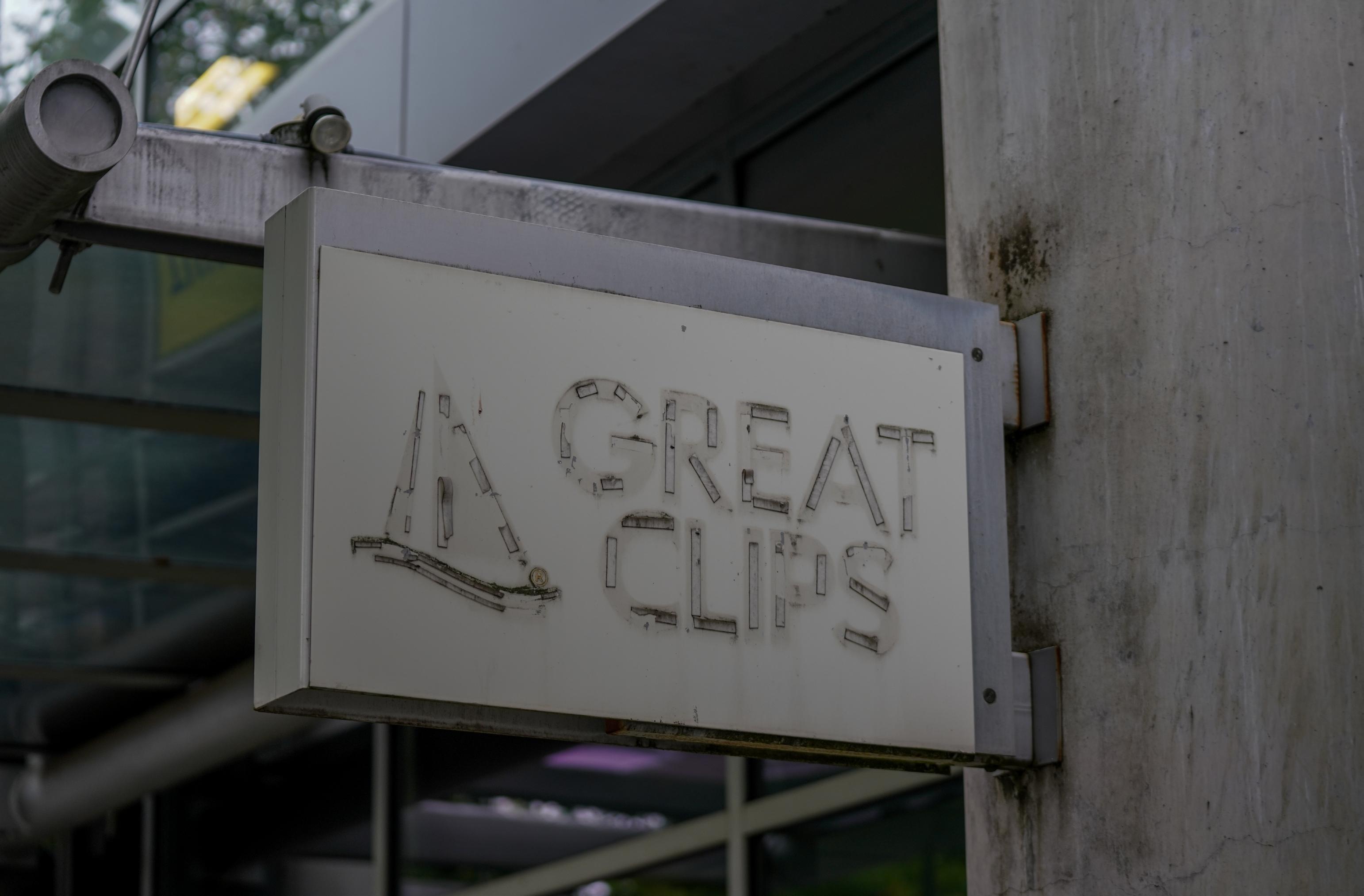
“We are also a longstanding and committed partner to the city, and I am ready to get to work along with other city leaders to turn Portland’s ship in a new direction.”
The release noted how PSU is the largest landowner in downtown Portland, stating that the university is an economic development engine.
There are some concerning aspects to note here. While PCCTF does have some government officials as members, it is predominantly composed of individuals from the business sector. Many of its members—including its co-chair—are business owners. Furthermore, the task force’s recommendations will be presented at the Oregon Business Plan’s Leadership Summit in December.
The issue areas PCCTF focuses on are skewed in a certain direction. According to KGW, the task force is divided into five groups: Central City Value Proposition, Livable Neighborhoods, Community Safety, Housing and Homelessness and Taxes for Services.
These are undoubtedly important issues, but this isn’t the right group to address them. I find it challenging to place trust in the Oregon Business Council to effectively address community safety. What does a livable neighborhood look like to businesses such as The Standard or Legacy Health? What does
community safety mean to Wells Fargo?
These are issues best addressed by the people of Portland, but we have yet to have a say on PCCTF. These meetings should be open to the public, considering the potential changes they might bring to our city. As PSU students, Cudd represents us on the task force, yet we have no idea what this representation entails. There is no reason this task force should operate in secrecy, yet it does.
In the end, there are two real outcomes for the task force. Either it makes no real difference at all—proving to be a waste of time for everyone involved—or it will make a meaningful difference to the city, in which case downtown revitalization will be carried out based on the interests of business owners and the Oregon Business Council. Neither of these are good options, and Portland deserves better.
Instead of focusing on negative issues which business owners are most concerned about, we ought to have an honest public debate about the direction we want our city to go. Our elected representatives are supposed to fulfill this responsibility.
If and when state and local governments form a similar task force for real legislative change, I will watch in anticipation. Until then, PCCTF appears to be another public relations stunt with no one in mind except business owners.
The Portland State University Faculty Association (PSUFA) announced Sept. 19 that they had reached a tentative agreement with the Portland State administration.
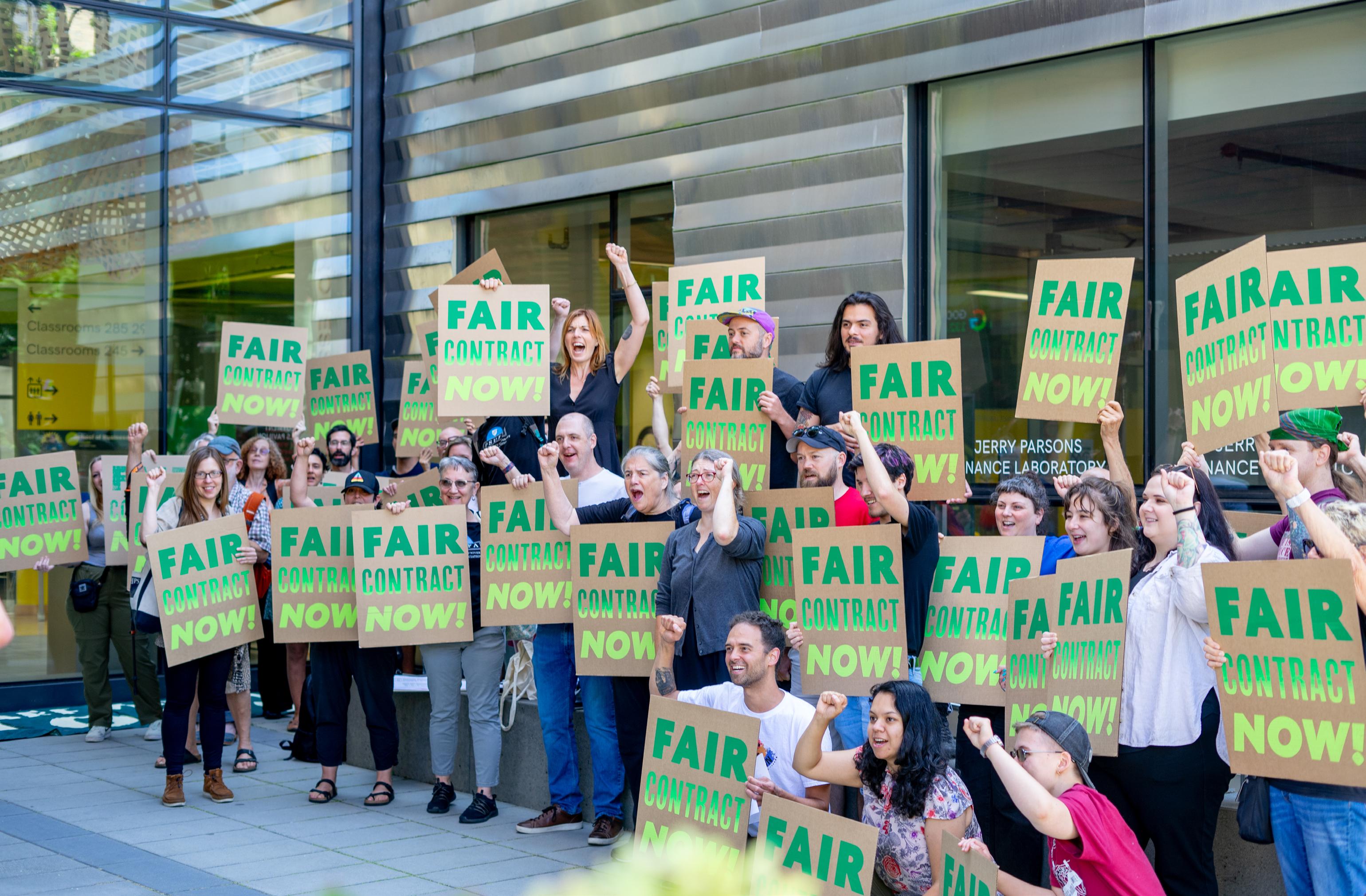
This tentative agreement—if approved by PSUFA members— includes a 10% Cost of Living Adjustment effective fall 2023, a 21% increase to the current per-credit minimum rate, length of service payment for six or more years of service, a 6% retirement pick-up, course development compensation, inclusion funds for adjuncts attending department meetings and increases to PSUFA’s Tech Fund and Adjunct Faculty Assistance Fund for caregivers.
PSUFA was voting on this contract and has been unavailable for comment. As the story develops, Portland State Vanguard will continue to provide updates via Instagram.
However, PSUFA is far from the only labor union working towards a fair contract.
Since early summer, both the Screen Actors Guild-American Federation of Television and Radio Artists (SAG-AFTRA) and the Writers Guild of America (WGA) have been on strike seeking protections from how streaming and other industry shifts have affected their livelihoods.
After five months of striking, on Sept. 24 the Writer’s Guild of America (WGA) announced a tentative agreement with the Alliance of Motion Picture and Television Producers. Though this deal is a positive step toward ending the strikes, it does not mean the entertainment industry will be up and running anytime soon.
Kyle Wallace is a Portland-based professional set-dresser, prop
person and member of the International Alliance of Theatrical Stage Employees. According to Wallace, WGA has expressed that they will not return to work until SAG-AFTRA reaches a deal as well.
“Although the scribes and WGA might be closer to coming to an agreement on a new contract, it sounds as though they will not go back to work until [SAG-AFTRA] has also come to a contract agreement out of solidarity between the two unions,” Wallace said. “Just because a new contract has been resolved, does not necessarily mean that work will be picking right back up again.”
Wallace—who has been out of work since June—said he thinks the advent of the COVID-19 pandemic was a paradigm shift that changed how people think about work.
“The event that transpired within the pandemic—of recogniz-
ing what is of value or of necessity to keep a community, a city, a state, a country moving—has really brought to light these labor inequities, so I’m grateful that there is this moment within the labor movement of speaking up to acknowledging what our worth is,” Wallace said. “It’s a great reminder that a majority of the people in the film industry are middle class, working class… Not everybody’s getting the same salary as our A-list celebrities.”
Wallace explained that television shows employ anywhere from 80 people full-time, and feature films employ 40–70 people full-time. Typically, Wallace explained that most film shoots are a minimum of 10 hours a day, sometimes six days a week. He said there is no full-time employment in the industry, especially in Portland.
“12-hour workdays six days a week is just exhausting,” Wallace said. “I’m grateful that there’s progress being made, and the requests are not egregious from the WGA or [SAG-AFTRA] for the new contract simulation.”
Since the pandemic, healthcare workers nationwide have been struggling with staffing shortages, staff burnout and increased patient needs. The Association of University Registered Nurses, the Oregon Nurses Association (ONA) and Oregon Health and Science University (OHSU) announced they reached a tentative agreement on Sept. 26 after 10 months of bargaining for a fair contract.
According to Oregon Public Broadcasting (OPB), nurses would see an average base pay increase of 37%. Union members will vote to ratify the proposal on Oct. 1 and 5. If ratified, the contract would last through June 30, 2026.
According to OPB, the last OHSU strike was in 2001. ONA represents approximately 3,000 nurses who voted almost unanimously at 95% to authorize a strike.

“Members of the negotiating team accused the hospital’s leadership of taking generous raises while neglecting frontline workers and problems with patient care,” OPB reported.
Duncan Zevetski—an oncology nurse at OHSU and vice president of the bargaining unit—said nurses at OHSU have seen increases in safety concerns and staff burnout. Zevetski explained how it would be the strongest contract OHSU has ever won, if they voted to ratify this deal.
“We’ve been bargaining this contract for 10 months now,” Zevetski said. “What’s in this contract is of exponential benefit to both our nurses and our patients at OHSU. It has guaranteed staffing language in it. We are the only contract in Oregon that has set ratios in our contract now that go beyond what the Oregon staffing law is. So that is a dramatic improvement of the status quo at OHSU for our patients and our nurses.”
Zevetski explained that safety concerns at OHSU have increased exponentially in recent years. Since OHSU is an open hospital, he said nurses have dealt with hostile and violent patrons alone.

“Our emergency department has a lot of access points, many of which are just left open,” Zevetski said. “That has resulted in people who do not need to be in our hospital getting into the hospital. When people are sick, they need to come to the emergency department. They need to come to the hospital. They’re stressed out. And then they’re put into a position where they’re crowded in, they don’t have a bathroom to use, there’s no food in the emergency department, they start getting escalated, agitated, and that leads to an increased likelihood that there will be a safety event. We recently had a patient who was able to make it through all the security in the hospital with a firearm, sat down in our emergency department, had it in their lap, and our nurses had to deal with it.”
However, this contract includes a wide variety of safety implementations and a guarantee that OHSU will spend $10 million implementing new and improved safety measures over the next three years. This spending will be dictated by nurses and other healthcare workers, not by executives.
The contract also features mental health guarantees and provisions allowing nurses to escalate harassment and discrimination claims.
Due to staffing shortages, Zevetski explained how OHSU nurses have been unable to provide the highest quality care to their patients.
“I have to prioritize my care and focus on the things that keep someone healthy and minimally safe by minimally improving in their care,” Zevetski said. “I do not have the time to do the things that are critical, to not just stabilize their health outlook but to emotionally support them in their care. Our emergency departments have patients in the hallways. They have patients in gurneys lining the unit, and they are not able to do any of that work. They’re just there to stabilize, get people moved into the hospital, and that’s it. With additional staffing, we will actually be able to provide the highest quality care we can give to our nurses or to our patients.”
Much like Wallace, Zevetski explained how COVID-19 was a tipping point for the industry and highlighted America’s healthcare insufficiencies. This has resulted in experienced nurses seeking alternative jobs due to the strain on their physical and mental well-being.
Zevetski said he regularly went entire shifts without sitting down or taking a break. This negatively affects patient care. Though many nurses have chosen to leave the industry because of these conditions, Zevetski hopes this new contract will bring them back.
“The overwhelming support for nurses in the Portland area has been tremendous, and we really appreciate that, and we hope that continues,” Zevetski said. “And I’m really excited for this contract. It’s a solid contract, and my hope for it is that we’ll be able to retain the nurses we already have, recruit really bright talented nurses from elsewhere, and just garner the respect that we deserve as healthcare practitioners and frontline workers here in Portland.”
The University Policy Committee revised a policy on July 31 regarding how students, staff and the public access campus buildings. These changes would consolidate control over access to the Campus Public Safety Office (CPSO) and will apply to all card readers responsible for unlocking doors to campus buildings.
The policy responsible is called the Electronic Access Control Policy. Initially revised on Dec. 17, 2019, this policy aimed to establish hours for Portland State staff, students and faculty to access campus buildings. The policymakers’ goal is to consider safety, prevent crime and establish procedures for when crimes involving campus buildings occur.

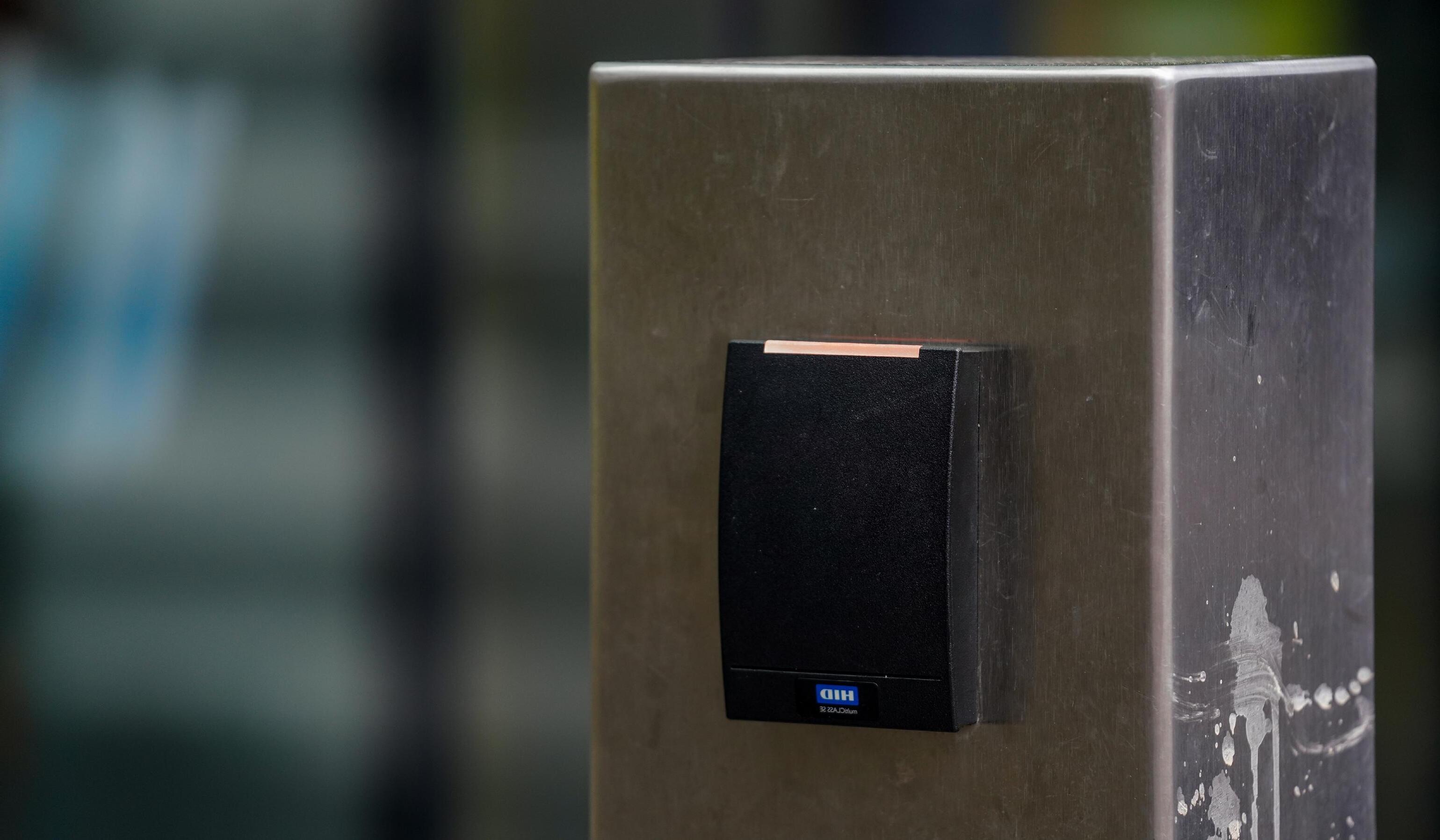
This summer’s policy revision changed the wording in some parts of the policy, defining the organization controlling the policy as the CPSO.
CPSO has become a figure of controversy among the PSU population in light of the recent rearming of campus police officers. As such, public comments expressed concerns about how putting the CPSO in charge of student access to buildings could bring about issues.
One primary goal of the policy revision is to streamline building hours of operation by putting one agency in charge of setting, maintaining and posting them. CPSO now keeps updated hours of operation for campus buildings on a website which students, staff and faculty can access.
“From my perspective, [it] was trying to make things more consistent,” said Caitlyn Phipps, the representative for the committee. “You can view [going to a website] as a hassle, but I would rather be able to go to one location and have those hours be correct.”
The approach received mixed responses from students and faculty during the public outreach process of the decision. A variety of stakeholders questioned the updates to the policy.
“PSU needs to feel like a normal university, and students need late-night access without applying for special permission,” one anonymous commenter stated. “Limiting access and shifting it
to the arbitrary decision of the CPSO is not a good idea at all.”
Another self-identified PSU staff member scrutinized the new policy for not reflecting the student body’s needs. “This policy change in my opinion is not student centered…” they stated. “All PSU buildings should have the same access and the same hours which is student centered.”
Public commenters also expressed concerns regarding the restrictions on staff members’ access to buildings.
“[I] have personally often wondered why we constrain employee and faculty access to the extent that we do,” said Michael McNerney—the officer in charge of handling public feedback on the policy—in response to concerns about staff access. “It is fairly unusual in the higher ed space. I will raise the question, and propose loosening that language to allow us to broaden access where appropriate for all community members based on the needs and functional requirements of each user group.”
Earlier this year, a flier was posted around campus criticizing the policy revision.
“PSU is planning to close all the campus buildings at night, and lock student[s] out unless they get special permission,” the flier stated. “Currently, all active PSU students have after-hours access by default to most campus buildings. Under this policy, we lose it.”
Phipps responded that this may result from incorrectly posted building-access hours. “Previously I believe we had some hours that were not consistent,” Phipps said. “So we got rid of that language.”
Whether or not students currently have access to buildings after-hours depends. For example, Shattuck Hall is open to architecture students 24/7, but students outside of that discipline cannot scan in using their cards.
“The last step in the policy process… both the president and the general counsel sign the policy,” Phipps said. Until that happens, the policy is not yet in effect.
CPSO did not respond to requests for comment on the issue.
The South Park Blocks were empty Sept. 23—the Saturday night before fall classes started. Campus was quiet, except for the south stairwell in Smith Memorial Student Union (SMSU) where students snaked down three stories in anticipation for Portland State’s annual Viking Days Drag Show.
Among the performers were Alexis Campbell Starr, T’Kara Campbell Starr, Nikki NiHao, Kourtni Capree Duv, Nay-Nay Leakes Cartier and Poison Waters herself.



“It’s one of my favorite events,” said Murph Murphy, the director of the Queer Resource Center (QRC) housed on the fourth floor of SMSU. “I love getting to kick off the year with this.”
This was the second year Murphy organized the event, and knowing what to expect from the event gave them an edge in planning it. Nevertheless, there were still challenges. “The biggest challenge is [the] quick turnaround,” Murphy said.
Housing was still helping new students move in, so a significant hurdle was ensuring students knew about the event. However, as students flooded in they nearly filled the ballroom. “We are talking about having it at a bigger venue,” Murphy said. “We don’t want to turn anyone away.”
By the time the event was getting started, around 300 eager attendees chatted amongst themselves. The music came on and some students vogued in their seats. Then, Waters pushed through the curtain to cheers from the audience.
Waters introduced the show and briefly flirted with audience members before refocusing on the night’s performers. The crowd seemed especially excited after discovering several performers had connections to PSU. T’Kara Campbell Starr and Cartier were both students at PSU. NiHao—whom students were particularly ecstatic about—is the current residence director at PSU’s
Students may be disappointed that the performance only occurs once a year, but finding any of the queens around town is relatively easy. Waters will be at the on-campus Dead Guy Bar—aka Rogue Hall—for Zombie Drag Queen Bingo on Oct. 12 and 24 at 7 p.m.
At the night’s end, Murphy fielded audience questions to the queens. They explained how they got their names, how one learns drag and how they trained. “Just sex, and you know…” Nay Nay Leakes Cartier said.
Before students left their seats, Murphy reiterated that the QRC doors are always open. After all, the QRC was the organization which brought everyone together that night. “Any student that wants to find support and find community—reach out,” Murphy said. “We’re here. We’re queer. We’re proud. We’re doing drag!"

Portland is home to a robust and diverse community of artists and creatives. You will not have to travel far from Portland State to experience it. Right on campus—inside Fariborz Maseeh Hall—is a free and public art museum with shows, events and exhibitions evolving all year round. The Jordan Schnitzer Museum of Art (JSMA) is a collaborative institution which intends to resonate with students across all disciplines, not just those studying art.
Currently on view at JSMA is an exhibition titled A Question of Hu: The Narrative Art of Hung Liu. This body of work features paintings, tapestries, lithography and collages created by the late Chinese-American artist Hung Liu.
Born in 1948 in Changchun, China, Liu lived through the Maoist Regime’s Cultural Revolution, through which her family was forcibly separated. Liu was sent to a reeducation camp as a young adult to perform agrarian labor for four years.
During this time, she defied state suppression of photography and artistic expression by photographing and painting her fellow laborers.
She studied education at Beijing Teachers College and mural painting at Beijing’s Central Academy of Fine Arts before relocating to the United States in 1984, where she received her Master of Fine Arts from the University of California, San Diego. Liu would become an art educator and one of the most appreci-
ated artists of our time. When searching “Chinese-American artists” on Google, her name is the first result on the page.
In many ways, the works on display at JSMA pay homage to Liu’s homeland, with symbolic references to Chinese film and literature, depictions of Chinese landscapes and culturally symbolic flora and fauna. However, the exhibition’s name reveals an underlying principle broader than China.
The exhibition is named after The Question of Hu—a 1988 semihistorical novel by Jonathan Spence which follows the story of John Hu, a Chinese Catholic who accompanies a Jesuit missionary to France. The novel ultimately addresses a cultural exchange between China and western Europe, notably to the detriment of the migrant Hu.
A Question of Hu is also the title of one of Liu’s massive multimedia paintings. Changing The Question of Hu to A Question of Hu may seem an inconsequential edit, but from definite to indefinite the change in articles was certainly no accident. The painting is situated right at the entrance of JSMA, ushering in glances through the glass exterior of the gallery.
This piece layers a patchwork of postcard memories atop a rural Chinese landscape. Two colorful boxes jut out of the painting, jolting the tranquil image into 3D reality. On these boxes are miniature bonsai trees, which Liu purchased in San Francisco’s Chinatown.
Like the novel, this work dissects the convergence of two places
and two histories within the context of Liu’s identity as a Chinese immigrant to the U.S.
“One way that [bonsai trees] are molded is through using wire to shape where the branches go, and one interpretation of why Hung Liu incorporated this is that maybe she also resonated in the ways that she also was molded [to adapt to] U.S. culture,” said Anna Kienberger, education and communications coordinator at JSMA and PSU alumna.
Immigration, forced migration and citizenship are themes— present throughout this exhibition. This is visible in paintings such as “Western Wind,” which illustrates a Chinese couple migrating on donkeys, a sense of urgency palpable as one of them breastfeeds.
Similarly, a three-piece series of Liu’s official self-portraits features her Chinese identification cards in the corners of the canvases. The pieces are titled “Proletarian,” “Immigrant” and “Citizen” and raise questions of identity, belonging and legal personhood.
Another unique aspect of Liu’s work is her signature use of particular symbols and shapes throughout many pieces. Liu attributed the dandelion as a personal symbol representing “her ability to thrive in the face of adversity,” Kienberger said. “They’re able to migrate and travel over vast expanses, even over oceans and take root anywhere and not only survive but also thrive.”
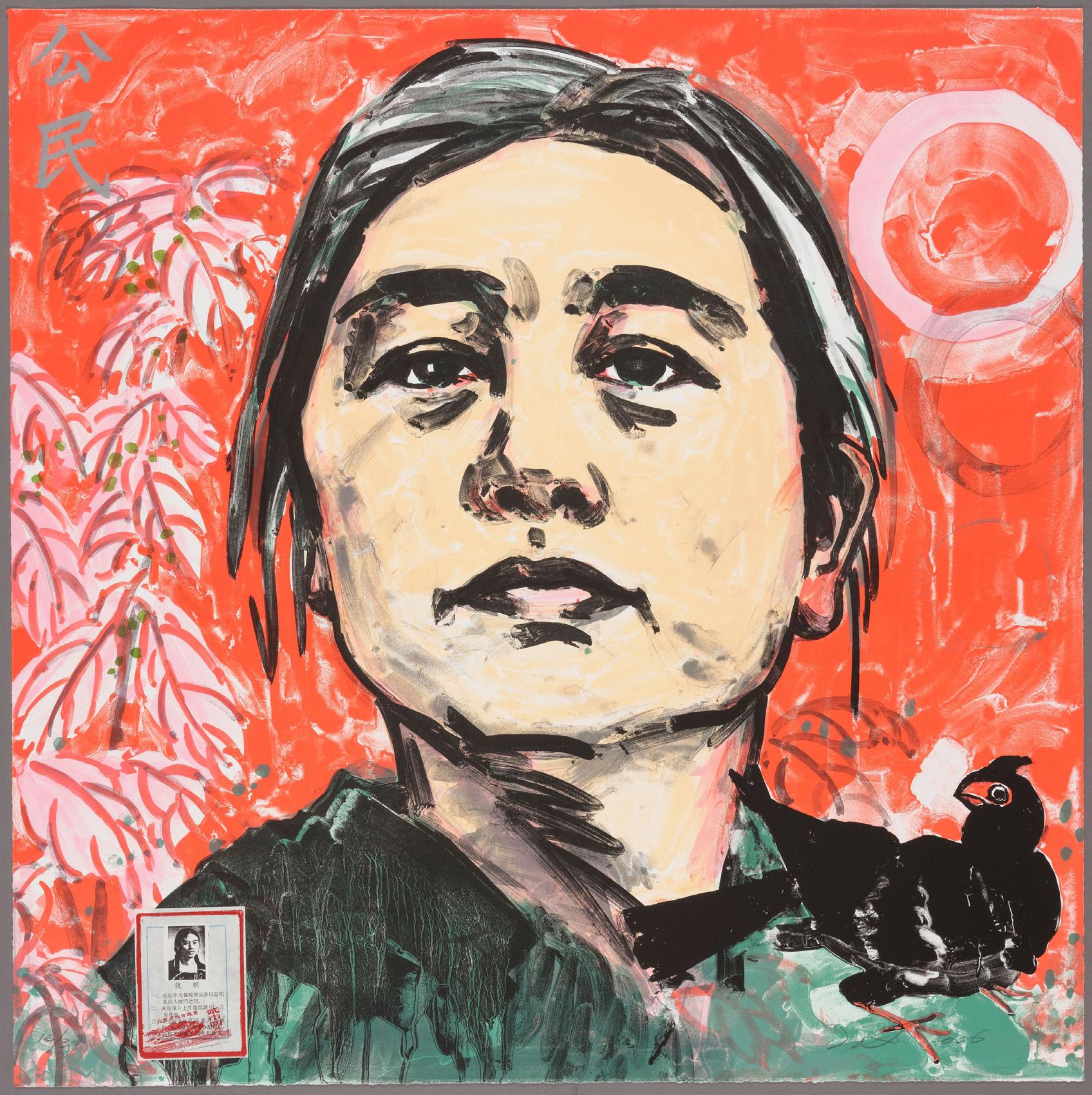
Considering Liu’s artistic emphasis on the immigrant experience, it is unsurprising that her work would set the stage for Portland’s city-wide, biennial exhibition titled Social Forms: Art as Global Citizenship
Social Forms is a free public event put on by the non-profit arts organization Converge 45. Liu is one of 50 artists whose work has been curated for this biennial and installed in various venues throughout Portland.
According to Converge 45’s website, the title Art as Global Citizenship “is designed to promote increased citizenship during a period of political polarization and retrenchment of civil liberties— where citizenship is a term used not to denote privileged political status but to propose a more inclusive category of belonging in the world.”
Thus, the art displayed in this biennial should reflect the same ideas as Liu’s work by deconstructing the notion that citizenship is solely a legal document.
“Citizenship is a fundamental right,” said Converge 45 curator Christian Viveros-Fauné at the opening ceremony for A Question of Hu “It’s a right to have rights.”
“Without it, the vulnerable, the poor, the refugee[s] don’t stand a chance,” Viveros-Fauné said. “And this is the kind of period—the period that we’re living through, that Joe Biden has called the cascade of crises—this is exactly the kind of period in which we need aesthetics.”
Indeed, A Question of Hu utilizes this aesthetic magnetism for social progress. Liu elevates marginalized identities in her work such as farmworkers, refugees and sex workers—honoring the stories of those who are often dismissed and minimized.
“Hung Liu—especially with her subjects of women and children, but just her subjects in general—really wanted to show them [with] a sense of dignity,” Kienberger said. “One way that she does that is by offering them a kind of precious token in many of her portraits of them.”
In 1991, Liu returned to China and discovered photos of sex workers and victims of sex trafficking in a photography studio. Liu paints these subjects with tokens of honor, such as a crown of flowers, a golden medallion or butterfly adornments.
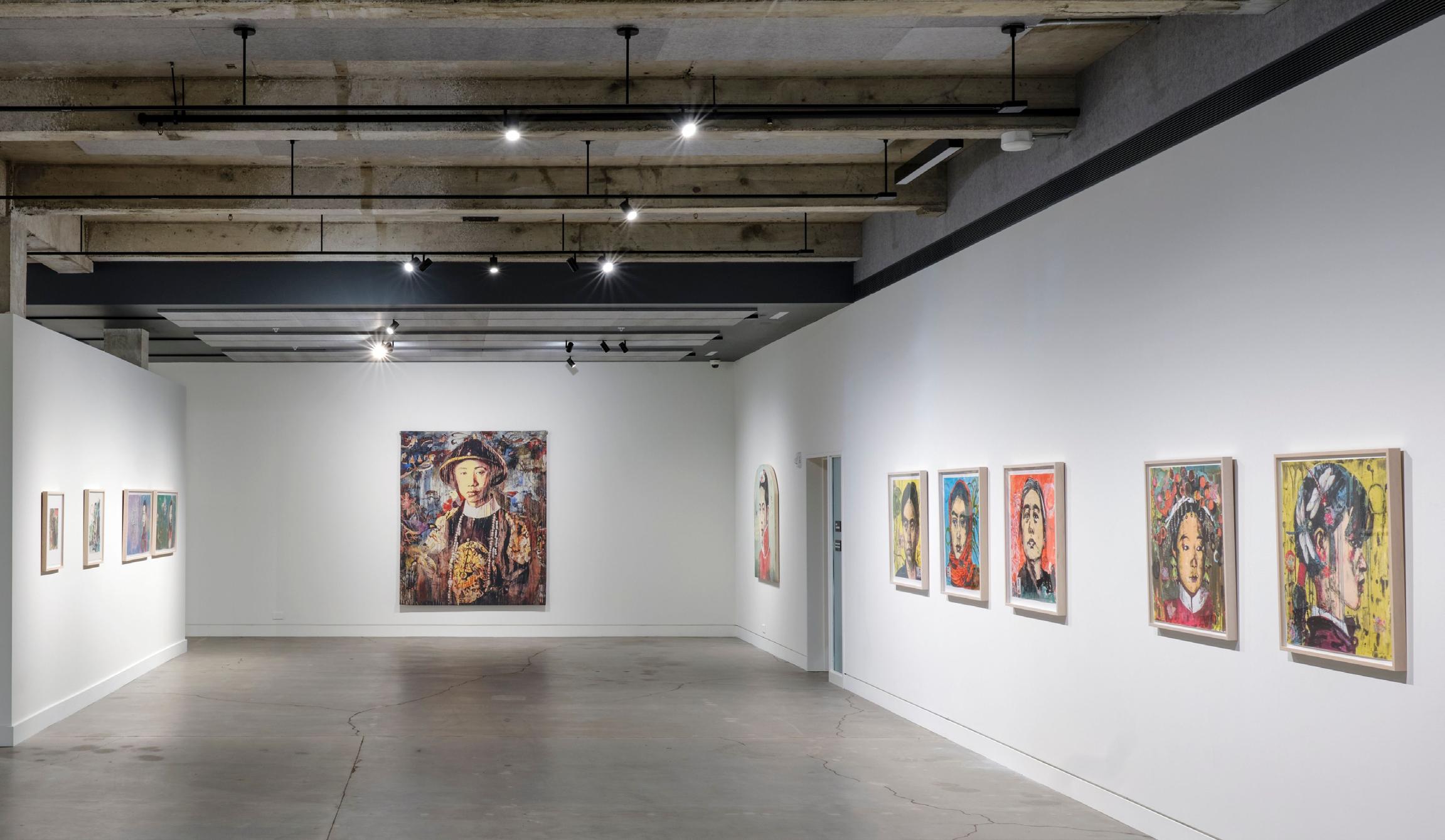
“I paint from historical photographs of people; the majority of them had no name, no bio, no story left. Nothing. I feel they are kind of lost souls, spirit-ghosts. My painting is a memorial site for them,” Liu said in an interview.
A prominent feature of these works is that the paint drips down the canvas, streaking certain aspects of the images to produce an effect reminiscent of streaming tears. In this way, Liu transforms the factual nature of these photographs into creations of abstraction and contemplation.
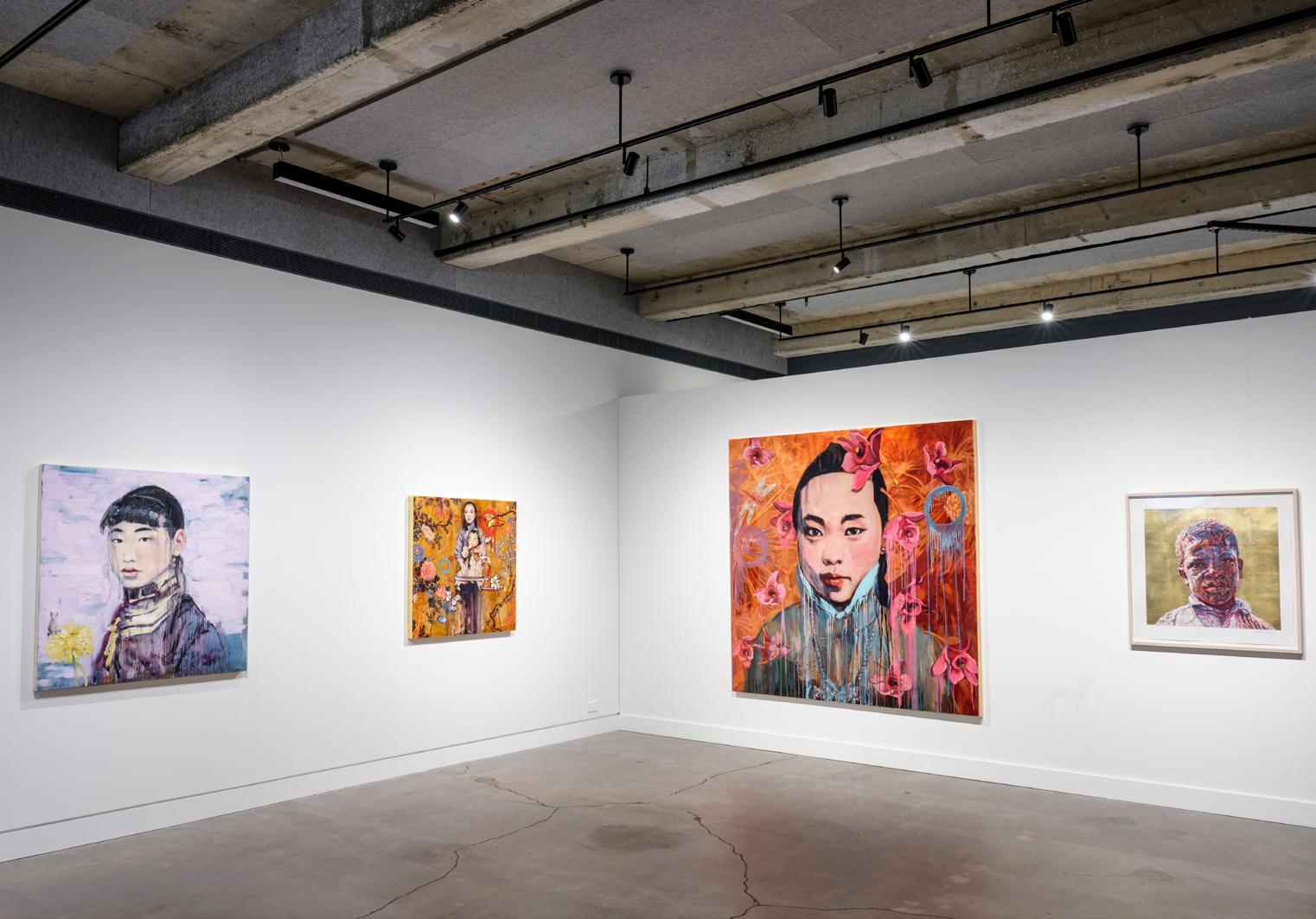
“She’s directly challenging the documentary authority of photography, as she is subjecting it to this really reflective process of painting, by creating this dripping wash…” Kienberger said. “She’s
trying to directly reference how memory slowly seeps into history.”
The portraits within this exhibition include many histories outside of China as well. Liu was inspired by the Great-Depression-era photographer Dorothea Lange, who was responsible for perhaps one of the most recognizable photographs in U.S. history, “Migrant Mother.”
Liu reimagines Lange’s photographs in larger-than-life paintings. “Sharecropper” foregrounds a young boy’s face overlaid on a bright tangerine backdrop. His image is filled with scrawling lines of neon color, blues, greens and yellows tracing the curves of his face and hair.
This colorful linework represents a topographical map, which Liu described as “hope, coming from the cracks between things.”
Liu’s artwork ultimately focuses on people living in dispossession. Liu depicts a shared human experience regardless of their origin or cultural background.

“This landscape of struggle is familiar terrain, reminding me of the epic revolution and displacement in Mao’s China,” said Liu about this era of her work. “Only now I am painting American peasants looking for the promised land.”
This exhibition considers
a wide range of content matters and social issues. To provide greater student accessibility for engagement with these works, JSMA has organized educational programs and events for the PSU community.
JSMA and Converge 45 uphold art as a means of activism. A Question of Hu provides a point of entry for community-building and developing understanding among people from different backgrounds.
Nonetheless, the museum encourages an open narrative for onlookers, in which Liu’s art can take on any number of meanings specific to the person engaging with them.
All images provided by JSMA. Copyright Hung Liu Estate/Artists Rights Society (ARS), New York.
The Viks recently faced the daunting task of playing against the University of Oregon Ducks—an in-state football powerhouse. The result was an 81-7 loss for Portland State. However, the financial implications are crucial to understanding college sports dynamics and how our football team earns money for its $15 million budget.
PSU’s game against Oregon was a classic example of a buy game—a practice where larger programs pay smaller ones for early-season matchups.
PSU is a program battling financial constraints which recently navigated a remarkable three-game stretch that vividly illustrates the economic challenges faced by universities competing in different divisions.
While the program generates revenue from various sources including ticket sales, sponsorships and philanthropic contributions—it also incurs expenses related to operational and personnel costs.
The Report on the Status and Future of Intercollegiate Athletics at Portland State University was presented to former President Steven Percy and the Athletics Future Committee (AFC) and published back in Nov. 2021. According to this re-
port, “the athletics department has sought to strike a balance between investing in the program’s growth and maintaining fiscal sustainability to ensure that it remains a contributing part of PSU’s overall financial landscape.”
It’s important to note that PSU belongs to the Football Championship Subdivision (FCS), while UO is part of the Football Bowl Subdivision (FBS). These divisions have varying scholarship requirements and postseason structures, with FBS institutions generally having more extensive resources and greater exposure.
In an interview with Gwinnett Daily Post, PSU’s Athletic Director John Johnson emphasized the necessity of games like the one against UO for resource acquisition. “You’ve got to play those games to put resources in your programs so you can grow your program,” Johnson says. “But that’s one of the quickest and easiest ways to do it other than getting playoffs and, you know, winning, but that helps pay the bills for not football necessarily, but for the rest of our programs that aren’t revenue generating by nature.” These matchups provide a means to infuse funds into the program and support non-revenue-generating sports within PSU athletics. However, it also raises questions
about the financial sustainability of smaller programs like PSU. PSU’s improbable journey also included an unconventional matchup against North American University, a team from the National Association of Intercollegiate Athletics (NAIA). NAIA represents a different tier of collegiate athletics, offering a cost-effective alternative for schools looking to manage their budgets more efficiently.
While PSU’s financial struggles in collegiate athletics garner attention, we are not the only school grappling with the complex question of why they invest millions in big-time football College football season brings with it the excitement of matchups between football powerhouses like University of Alabama, University of Southern California, Clemson University and University of Georgia. For these programs, the goals are clearbowl games, championships and substantial revenue from TV deals. However, motivation behind participating in big-time football is less straightforward for many other schools.
Success on the gridiron can also foster a sense of community, attract students and stimulate donations. Certain schools such as the University of Notre Dame, Michigan State, and Penn State have leveraged their football income to become

academic powerhouses.
According to the report, PSU’s non-conference scheduling reflects a delicate balance between generating revenue and maintaining competitive opportunities. The Big Sky Conference—of which PSU is a member—prescribes a specific scheduling format which includes a mix of guaranteed games and conference matches.
Securing home games is crucial for smaller programs such as PSU in order to generate interest and revenue, even if they have to be played in Hillsboro due to limited resources on campus.
In considering the future of PSU’s athletics program, the AFC has identified four options in the report. This is where the 2021 AFC report lends us the knowledge of the four options they thought could help build the ship. Each option comes with its own pros and cons.
“No Change in Program Offerings but Increase Institutional Support,” stated the first option. This aims to maintain PSU’s athletic program while advocating for increased institutional support. While this approach would cause the least disruption to the athletics department, it recognizes the need for addi tional resources to ensure competitiveness.
According to the report, PSU athletics has historically faced underfunding compared to peer institutions, which has ham pered its ability to field competitive teams. Collegiate consult ing data collected for the report revealed how universities with the most competitive success in Big Sky allocate budgets rang ing from $18.3 million to $23.2 million—significantly higher than PSU’s allocation.

To maintain the current program, PSU must increase in stitutional support and develop a strategic plan for revenue generation from sources such as ticket sales, sponsorships and philanthropy.
However, pursuing this option involves challenges, including potential opposition within the PSU community to increased
athletic investment and no guarantee of improved program competitiveness.
Additionally, PSU may need to consider building a football facility closer to campus, requiring donor support and a feasibility study. The evolving National Collegiate Athletics Association (NCAA) restructuring of college sports may also impact the viability of this option, potentially affecting scheduled football games and necessitating new revenue sources.
The second option entailed staying in NCAA Division I but
revenue and diminished alumni and donor engagement. PSU may also incur exit fees and penalties under existing contracts if it withdraws from its current conference or terminates football.
The committee acknowledged that the divisional landscape may evolve, but in the current structure this option may not be in PSU’s best interests without a more thorough analysis of its costs and disadvantages.
The final option entails phasing out intercollegiate athletics at PSU, which according to the report tended to be the least-
The

Dear editor:

It was quite upsetting for me as a 1971 PSU [alumnus] to see the 81-6 thrashing of the once proudly successful Viking football team of University of Oregon just to pick up a much needed influx of cash from the game played in Eugene. Our much under-manned team was served up as practice dummies in the game played in Eugene.
It makes me wonder if continuing PSU’s underfunded football program that no longer has a stadium within walking distance of campus to play home games… is worth going forward with beyond this year?
Sincerely,
Doug Weiskopf ‘71perspectives and opinions printed in this Letter to the Editor are the views of the author(s) and do not necessarily represent the positions of Portland State Vanguard or its editorial staff.WHITNEY McPHIE
A dump truck backed into an empty lot at the corner of Montgomery Street and 12th Avenue on a recent Tuesday morning. Cleo Needham—the garden coordinator with the Student Sustainability Center (SSC)—was there to greet it, her bike sitting off to the side. Needham directed the plaidwearing, mustached man in the driver’s seat. SSC is preparing for a planting event on this lot, which is a significant change considering its eight years of sitting empty.
This lot is now being called The Green. The near quarter-acre of land sits on 12th Avenue across from Stephen Epler Residence Hall, south of Parking Structure 3 and below the constantly whirring traffic on the exit ramp from Interstate 405 to United States Route 26.
The well-cared for community orchard—leased from the Oregon Department of Transportation and managed by SSC—abuts the south of the lot. It starkly contrasts the empty lot in question.
This lot hasn’t always sat empty. In the early 2000s, a student named Maude Haney was sitting at the now-demolished Metro—a coffee shop at the base of what was King Albert Residence Hall— when she overheard a couple of resident assistants complaining about being in over their heads with to-do’s at their garden plots.
It turned out this garden was a block away and was managed by students housed at one of the College Housing Northwest buildings. She soon had a garden bed and eventually took on the garden coordinator position.
“When I got a hold of the garden, it had gone through a bit of neglect,” Haney said. “But there was always something going on there.” Haney saw her role as a transitional one—to help manage events and train the incoming coordinator.
Students who used their plots supplemented their groceries with fruits and vegetables grown in the garden. However, it wasn’t just a garden. It was an opportunity to build community. “We would do barbeques for all the residents,” Haney said. “We even had movies in the garden.”
Management of the lot changed in 2005. From then on, it was managed by Portland State’s Residence Housing Association (RHA) for students housed on campus only. In 2015, the garden lost its coordinator, and for three years it sat unused.


In 2018, RHA returned the lot to PSU for general use. That’s around when SSC submitted a proposal for the lot’s management. Nearly a year later, PSU approved SSC’s proposal and management of the lot was handed over to them.
Around that time, a survey was conducted to understand what students and faculty wanted from the lot, and SSC based their goals on the responses. Those goals were to “build upon existing successful Orchard programming to create a safe and accessible space for the PSU community,” “provide new opportunities for garden education and service events,” and “increase campus habitat and outdoor space.”
However, SSC was working with a tight budget. Until then, the garden was funded through a student housing fee. SSC received $50,000 when it took hold of the lot.
“We spent the majority of those funds on sloping it, getting water access and making it so that it was more ADA accessible,” said Serena Dressel, the SSC coordinator. “Currently we have about $15,000 left.” Because of the limited funds, their priorities have shifted.
“Our community engagement is less focused on the design of the space and what we should have in the space and more focused on how we can plan for it to be a campus and community resource,” Dressel said. Among these plans are open-to-all garden beds and an outdoor classroom.
Megan Horst—associate professor and director for the master of urban and regional planning program—focuses her research on urban agriculture, among other things. She grew familiar with the lot over the past several years, passing it on her commute to and from campus.
“There’s a lot of evidence that points to the mental health and community benefits of green infrastructure,” Horst said. She also believes the project will help activate the area on the western edge of campus which has been neglected for many years.
“Projects like this without a lot of programming or activation can
fall into neglect and can work against the intended vision of those carrying out the projects,” Horst said. “They need to be resourced.”
Although SSC is working with a tight budget, its programming for the upcoming year is ambitious and will focus on ensuring the project’s sustainability.
“We’re planning on focusing on community engagement for the rest of the year, maybe having a big event in the spring that’s really interactive,” Dressel said. “We are hoping to purchase a storage container that can be part of our storage needs as well as those for an outdoor classroom. During that event, we’d like to paint a mural on the container, and we’d like to get more feedback from different groups.”
SSC’s goal to ensure a sustainable approach for the garden doesn’t end there. “We have a new community engagement coordinator and leadership fellow,” Dressel said. “And so they’ll take the lead and I’ll make decisions with them collaboratively on what this year should look like… We really want it to be an inclusive space that feels culturally affirming and welcoming and a space that’s designed for multiple groups at PSU.”
Down a grass path and hidden away on the side of a highway, Clackamas High School enjoyed a field trip at Rock Creek. Students spread out down the stream to collect data for their class and a master sheet of data which spanned multiple years collected continuously by thousands of students.
Students immersed in their environment could see living, moving samples rather than the sterile still pictures of river invertebrates. This place offers an accessible outlet, both for students to explore science and for scientific research to be expanded through student involvement.
This was an opportunity to introduce students to scientific knowledge and spark their interest. By providing experiences like exploring a creek, students could discover new interests they never knew they had.
“Students get to get out of the classroom with their peers and interact with each other and professionals out in the field,” stated Elisa Mickelson, the environmental science student leading the experiment in the creek. “I think it helps strengthen community relationships and gives students an opportunity to explore science in a way that just isn’t possible in the classroom.”
Engaging with the environment is a perfect place to learn science and see it occur since our environment surrounds us. Some people might see nature and people as juxtaposed, but these are more often mixed.
The wilderness can be experienced and appreciated in far more ways than just camping, hiking and backpacking—an interaction based on our chosen engagement and interest in said activity. Water flows from the mountains, moves past the city and leaves through the ocean. Our relationship with nature is innately intertwined. Community science values people’s ability to interact with their
environment, report their findings and influence our growing understanding of our world. Beyond the scientific part, there is the social potential.
We can work towards a collective understanding of things with community science, expanding them beyond academics and development. We’ve collected knowledge and spread it, but making it tangible for people and actionable can be that needed step of participation past interest alone.
Dr. Patrick Edwards is an environmental scientist who has worked hard to develop these programs which get students involved and practice high-level scientific work. “We had about 100 students show up to a county council meeting and symbolically vote for funding for continued restoration and education around restoration,” said
Edwards, speaking about an experience where community science promoted action. “And to me that was the highlight of my career. I thought it was the coolest thing ever.”
These interactions are essential for engagement in publiclyfunded work and knowledge of local projects. Even if people aren’t working directly on restoration and conservation projects, there are plenty of areas where people can plug in and show support. These students interacting with nature a few blocks from their high school is a great example of how communities might realize how much life is actually around them.
When we consider the wild around us, it creates bonds of knowledge and more personal attachments. Without consideration of knowledge, we form biases against the things which are around us. It’s harder to not be afraid of bugs if you think all of them will bite you, often leading to an indiscriminate treatment of all insects, even ones which eat bugs like mosquitos.
For urban areas such as Portland, people might not consider the plants around them as anything significant. Plant blindness is a term used to describe the cognitive bias towards plants with an inability to distinguish them in a meaningful way. This is how plants are categorized as just weeds, or different varieties of trees as just trees.

This is especially important in urban areas where invasive species are seen as green even when they are detrimental to the ecosystem around us. Plants that can be identified and recognized for their unique qualities, botanical benefits and ecological significance.
Community science can empower people to interact with the knowledge being produced, and even use this knowledge to inform actions and decisions which impact our society. The more we invest in knowing about something, the more likely we are to want to protect it.
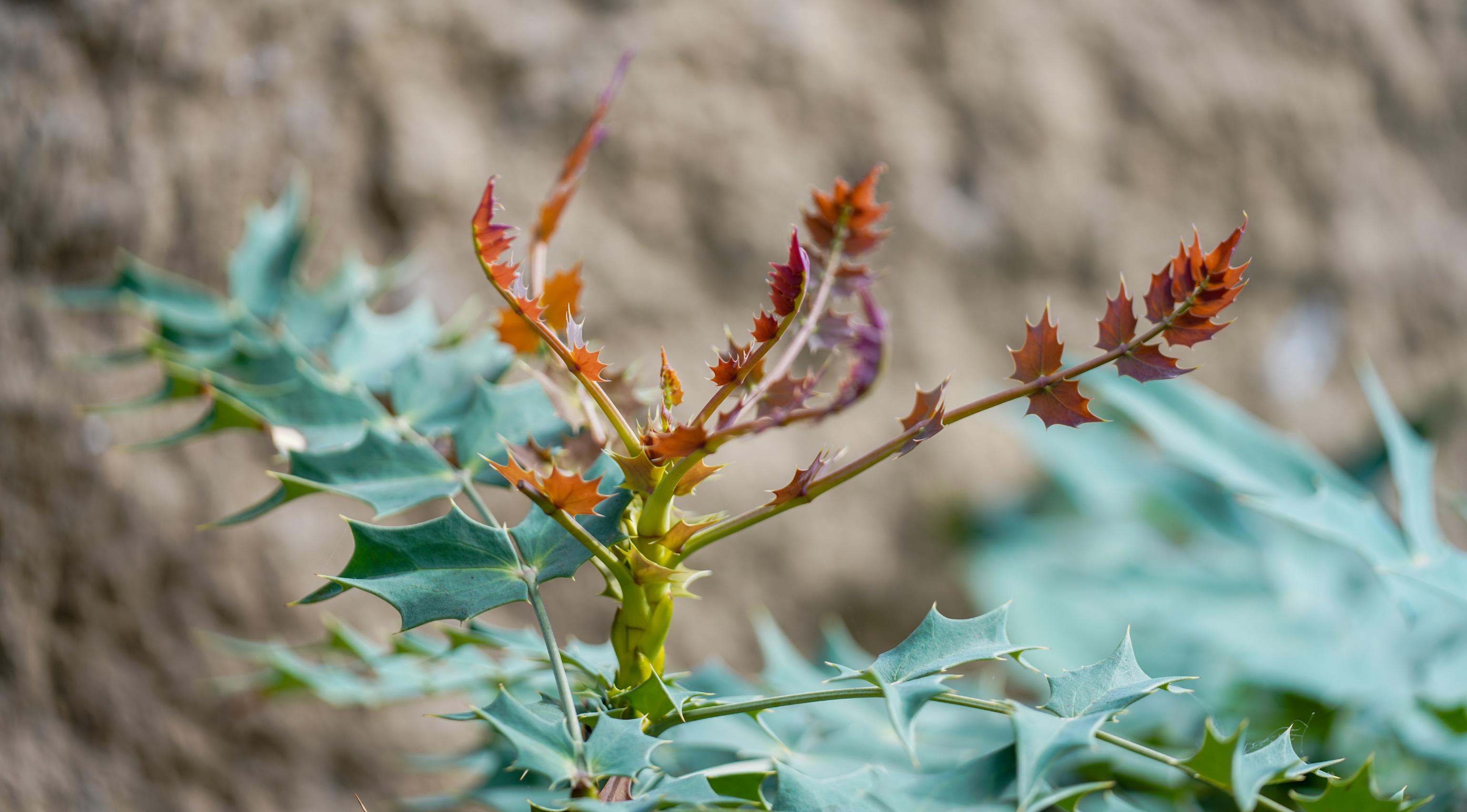
Parkway North in SMSU
Tuesdays/Thursdays, 12-1 p.m.
Free
A music series for students by students. A place to study, eat, meet local bands and make new friends!
Vietnamese Student Association
101
SMSU 327
Oct. 9, 5 p.m.
Free
Join us for the first VSA workshop of the term. Play some games and make new friends.
KMC 262
Oct. 10, 4:15 p.m.
Free
Come hang with FMA, meet new people and play some business-themed bingo!
Women’s Resource Center
Oct. 11, 4 p.m.
Free
FOCCP centers on the lived experience of students of color, and fosters community through storytelling, connection and exploring dialogue of feminist possibilities
SMSU Parkway North
Oct. 11, 4:30 p.m.
Free
Join MBSA for their first event of the year with some boba, make new friends and network with PSU’s student community
Forest Park Nature Hike
Outdoor Program Office
Oct. 15, 8 a.m. (register by Oct. 11)
$50 for Campus Rec Members
Discover the beauty of Oregon’s temperate rainforests. Encounter everything from tiny mushrooms to towering douglas fir trees
PSU Basic Needs Hub
SMSU Suite 435
Mon–Fri, 9 a.m.–5 p.m.
Free for students
Helps students access resources such as funds, food, housing, employment, childcare and health support
PSU Food Pantry
1704 SW Broadway (temporary location)
Tues–Thur, 12–4 p.m.
Free for students
Access to free groceries in a welcoming, equitable, trauma-informed way. Must be enrolled in at least one credit for summer or fall.
Recovery Meetings
University Center Building 340 E
Times vary
Free
In peer recovery, students with shared experiences connect to reduce stigma and build a campus recovery community
Online
Thursdays 11 a.m.
Free
Come together as parents in a relaxed setting to support each other, share ideas, collaborate and commiserate
Community Technology Space
730 SW 10th Ave. Suite 111 (entrance on SW 9th Ave.)
Mon–Fri, 10 a.m.–6 p.m.
Free
Multnomah County official cooling center with access to free technology, internet, limited books and events
Varying Locations
Mon–Fri, hours vary
Free
Provides energy bill assistance to low-income Oregonians to support household stability
UCB Suite 310
Mon–Fri (by appointment)
Free for students
Solo space to experience biofeedback, light therapy, meditation, massages, relaxation and more. Must be enrolled in at least five credits for summer or fall.
Listen on Spotify
Available 24/7
Free
PSU-produced podcast about being mindful while outside, practicing gratitude, finding joy and being in the moment
Download on App Store or Google Play
Available 24/7
Free
Connecting students with free, confidential mental health and wellbeing support
Watch on Youtube
Available 24/7
Free
PSU Campus Recreation Center staff videos about topics ranging from Leave No Trace and plant identification to hiking spots and land acknowledgments
Watch on Zoom
Mon–Sat, hours vary
Free
Bay Area Outreach and Recreation Program’s (BORP) virtual exercise classes for people with physical disabilities
Watch on Youtube
Available 24/7
Free
Using fun and popular stories to get kids engaged in a calm, relaxing, mindful workout